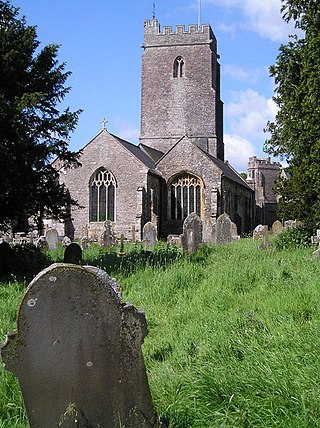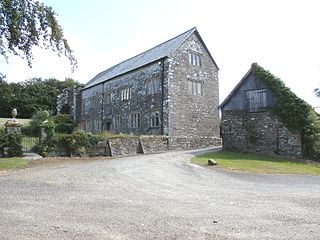
Holcombe Rogus is a village, civil parish and ecclesiastical parish in the English county of Devon. In 2001 the population of the parish was 503.
Margaret Campbell Speke Cruwys née Abercrombie was a British archivist and historian, specializing in the history of Devon. She was born in Ayr, Ayrshire, Scotland, and was the daughter of Alexander Houghton Abercrombie, an officer in the 21st Royal Scots Fusiliers. She married Lewis George Cruwys of Cruwys Morchard, Devon, on 19 November 1917 at St David's Church, Exeter. She became a member of the Devonshire Association in 1931 and was elected president in 1952. She was a member of the Devon and Exeter Institution, serving first as their secretary and then as president. Cruwys was editor of Devon and Cornwall Notes and Queries for thirty years. She was awarded a Fellowship of the Society of Antiquaries of London in 1950 for the work she did indexing and cataloguing the large collection of family papers held at Cruwys Morchard House. She died on 12 March 1968 at 31 St Peter Street, Tiverton, Devon, and was buried on 18 March 1968 at the Church of the Holy Cross, Cruwys Morchard, Devon.

Morchard Bishop is a village and civil parish in Mid Devon in the English county of Devon. It has a population of 975, and contains a primary school, two churches, and a playing field with tennis court. Notable past residents include Ernest Bevin.

Frithelstock is a village, civil parish and former manor in Devon, England. It is located within Torridge local authority area and formed part of the historic Shebbear hundred. The parish is surrounded, clockwise from the north, by the parishes of Monkleigh, Great Torrington, Little Torrington, Langtree and Buckland Brewer. In 2001 its population was 366, down from 429 in 1901.

Robert Geoffrey Cruwys was an English cricketer and clergyman. He was born in the family manor, Cruwys Morchard House, located in Cruwys Morchard, a small parish in Devon which takes the name from the Cruwys family who have been Lords of the Manor here since the reign of King John (1199–1216).

Huish is a small village, civil parish and former manor in the Torridge district of Devon, England. The eastern boundary of the parish is formed by the River Torridge and the western by the Rivers Mere and Little Mere, and it is surrounded, clockwise from the north, by the parishes of Merton, Dolton, Meeth and Petrockstowe. In 2001 the population of the parish was 49, down from 76 in 1901.

Collaton St Mary is a village, parish and former manor in Devon, England, situated about 2 miles (3 km) west of the town of Paignton. The village is bisected by the A385 Paignton to Totnes road. The parish is now administered within the unitary authority of Torbay, Devon.

John Acland was described as "the first of the [Acland] family to emerge from the shadows of history as a visible human being". His great-grandson was the Royalist colonel Sir John Acland, 1st Baronet of Columb John. Little if anything is known of his life and career, he was possibly a minor Tudor official, but he is chiefly remembered for his surviving portrait which is displayed at Killerton House, the earliest surviving image of an Acland and one of the most cherished in that family's former collection, now owned by the National Trust.

Bremridge is a historic estate within the former hundred of South Molton in Devon, England. It is now within the parish of Filleigh but was formerly in that of South Molton. It is situated 8 miles north-west of South Molton. Since the construction of the nearby A361 North Devon Link Road direct access has been cut off from Bremridge to Filleigh and South Molton. The surviving wing of the mansion house built in 1654 is a Grade II* listed building. Bremridge Wood is the site of an Iron Age enclosure or hill fort, the earthwork of which is situated on a hillside forming a promontory above the River Bray. In Bremridge Wood survives a disused tunnel of the former Great Western Railway line between South Molton and Barnstaple, much of the course of which has been used for the A361. The tunnel is 319 yards long and was identified as "Bremridge Tunnel" in the 1889 Ordnance Survey map but as "Castle Hill Tunnel" in subsequent editions.
Walter I de Claville was an Anglo-Norman magnate and one of the 52 Devon Domesday Book tenants-in-chief of King William the Conqueror. He also held lands in Dorset. His Devonshire estates later formed part of the feudal barony of Gloucester.

The Domesday Book of 1086 lists in the following order the tenants-in-chief in Devonshire of King William the Conqueror:
William Cheever was one of the 52 Devon Domesday Book tenants-in-chief of King William the Conqueror. He held 46 landholdings in Devon. His lands later formed, the feudal barony of Bradninch, Devon. His brother was Ralph de Pomeroy, feudal baron of Berry Pomeroy, Devon, with whom several of his holdings had been divided into two parts, one for each brother. His sister was Beatrix, who held from him the manor of Southleigh.
Ralph de Pomeroy was one of the 52 Devon Domesday Book tenants-in-chief of King William the Conqueror and was the first feudal baron of Berry Pomeroy in Devon. He held 58 landholdings in Devon.
Gotshelm was an Anglo-Norman magnate and one of the 52 Devon Domesday Book tenants-in-chief of King William the Conqueror and was also a Cornwall Domesday Book tenant-in-chief. He is listed in the Domesday Book of 1086 as holding 28 estates or manors in Devon from the king. His brother was Walter de Claville, also a Devon Domesday Book tenant-in-chief, who held 32 estates or manors in Devon from the king.

Washfield is a village, parish and former manor in Mid Devon, Devon, England, situated about 2 miles north-west of Tiverton. The parish church is dedicated to St Mary the Virgin. It was within the jurisdiction of the historic West Budleigh Hundred. In 2001 the parish had a population of 362.
Ansger of Montacute was one of the Devon Domesday Book tenants-in-chief of King William the Conqueror.

Lyneham in the parish of Yealmpton in Devon, is an historic estate. The surviving grand mansion house known as Lyneham House is a grade I listed building. It was built c.1699-1703 by Sir Courtenay Croker, MP for Plympton Morice in 1699. A drawing of Lyneham House dated 1716 by Edmund Prideaux (1693–1745) of Prideaux Place, Padstow, Cornwall, survives at Prideaux Place. It shows formal gardens in front with flanking pavilions and an orangery.
The manor of Hillersdon was a historic manor in the parish of Cullompton, Devon, England which was held by the de Hillersdon family from the 13th century until the early 16th century. It was then held by a number of different families including the Cockeram, Cruwys and Grant families. Hillersdon House was built in the nineteenth century by the Grant family and is still in use.
The manor of Alverdiscott was a manor situated in north Devon, England, which included the village of Alverdiscott.
Croker's Hele is an historic estate in the parish of Meeth in Devon, England.















